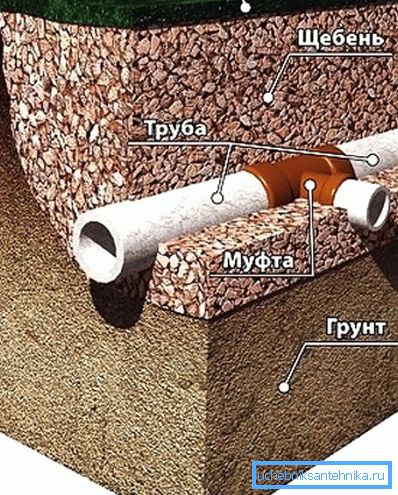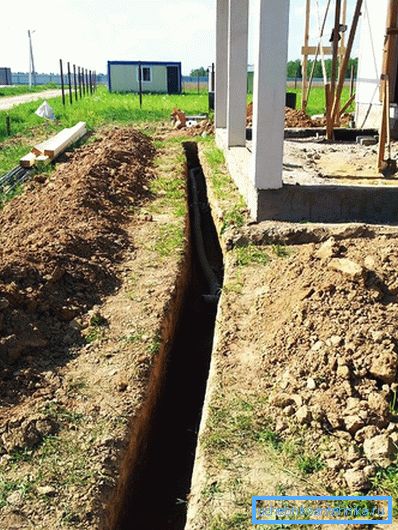Laying drainage pipes yourself
The drainage area is a large set of measures aimed at the removal of excess water. The system is a complex of pipes (drains) laid in the ground. With their help, and the removal of excess moisture from the site. But in order for drainage to work efficiently, it is necessary to correctly select and install drains. This will be discussed in the article. Here you will learn about the main types of drains used and how to lay the drainage pipes with your own hands.
What pipes should be used for drainage

For drainage systems use special pipes with many holes. Through these holes, water from the soil enters the drain and then is removed outside the site. As a material for pipes, various materials can be used:
- asbestos cement;
- ceramics;
- polymeric materials.
Asbestos-cement and ceramic pipes are practically not used today. Such products are quite heavy and difficult to install, and the use of metal pipes in the drainage system is impractical. Metal is amenable to corrosion, so the pipes lying in the ground can fail in a year.
The most common are the last from the list of materials - polymeric. And there are many reasons for this. First, plastic is much lighter than asbestos cement and ceramics. This factor facilitates pipe laying. At the same time, the strength of modern polymeric materials is often not inferior even to metal. Secondly, such products are cheaper.

In addition, plastic drainage pipes have other positive characteristics:
- have a long service life;
- easily tolerate exposure to aggressive media and are not susceptible to corrosion;
- The inner surface of the plastic pipe is absolutely smooth. This feature prevents the formation of blockages;
- resistant to silting. If the drains are laid with geotextiles, then fine particles do not clog the holes. This means that water from the soil freely flows into the drainage system;
- a wide range of sizes. Plastic pipes can easily pick up to the drainage system of any capacity.
In addition, plastic products do not require special care. During operation, it is only necessary to periodically conduct a visual inspection and, at most, once a year, to clean the system using any of the available methods.
Laying technology

Now let's figure out how to lay the drainage pipe itself. The styling technology is quite simple, and anyone can handle it without even having special skills.
At the first stage, the system design is done. It should consider the following factors:
- terrain (the presence of natural slopes and hills);
- the location of the site (in a valley or on a hill);
- soil characteristics (its ability to pass water);
- groundwater proximity;
- precipitation

Calculations of the pipe depth and their location are made. After that we transfer the markup to the terrain. Now you can proceed to earthworks. On the marked lines digging trenches. Their depth should correspond to the calculations, and the width should be 40 cm greater than the external diameter of the drainage pipes used. This additional space is necessary for arranging the filter in the form of a layer of crushed stone of small and medium fractions.

The next step is to prepare the pillow. At the bottom of the trench, 20 cm of sand is poured and carefully rammed. After that we fall asleep a layer of crushed stone of the same thickness.
Observe the slope of the digging trench in the direction of the drainage well or the place of withdrawal of water from the site. The slope must be at least 3 cm per meter of pipe.
Now you can lay drains. It is necessary to monitor the location of the holes. If the perforation is performed only on one side, the pipe is laid with the holes down. After laying the pipes we carry out their connection into one system. To do this, you can use plastic fittings used in the installation of an external sewage system.
At each turn of the system or at the joints of several pipelines, a viewing well is installed. It can be purchased already in finished form (as a rule, they are also made from polymeric materials) or built independently (from concrete rings, brick or other improvised material).

Then a layer of rubble, 20 cm thick, is poured over the pipes, then sand (the same layer). After that it is possible to carry out backfilling with previously excavated soil. The turf is laid on top, which should be cut before digging trenches.
To prevent the drainage system from being silted, it is advisable to use geotextiles. In this case, before laying the first layer of rubble, the geofabric is spread. Then rubble is filled up, a pipe is laid, another layer of rubble, and the whole “cake” is covered with the edges of the geofabric. As a result, the entire filter system must be placed in a “wrapper” of geotextiles.
Maybe you will be interested to get acquainted with additional materials on the topic:
- Strengthening the drainage ditch
- Arrangement of drainage well
- How to make a drainage area
Video
From the provided videos, you can learn how to do drainage in the country with their own hands, as well as how to choose a pipe for drainage: